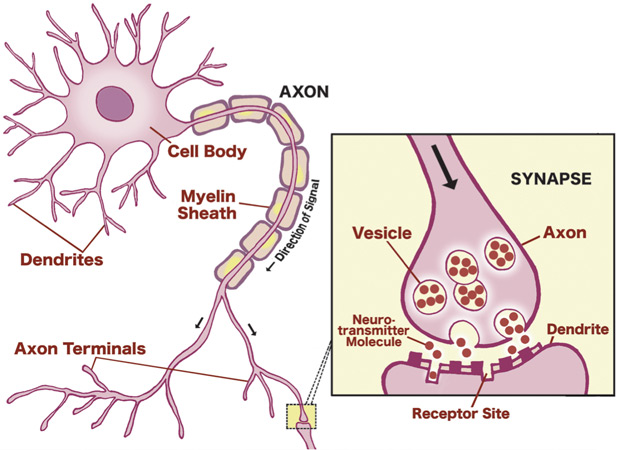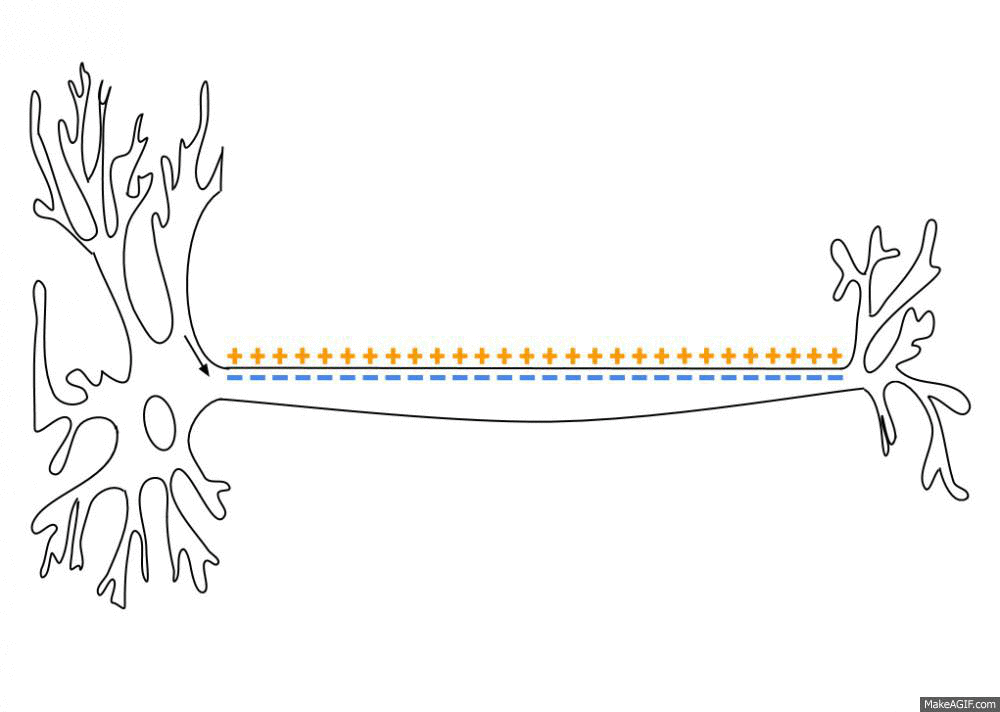Brainwaves
The brain is composed of millions of neurons, or nerve cells, which are able to transfer information through electric signals. Brainwaves are exactly that - the electrical impulse passed between two neurons. To understand how brainwaves are created, it is necessary to discuss structure of a neuron itself.
 |
| Neuron Structure and Chemical Signal |
Neurotransmission triggers the relay of an electrical signal through a chemical action potential (an impulse). The potential travels down the axon, prompting the Na+ and K+ membrane channels to open and release chemicals. This creates a polarization; outside the membrane is positive, inside is negative. The ion channels allow ions to pass in and out of the membrane in accordance with the signal from a previous neutron. The Na+ and subsequent K+ ion releases cause depolarization then repolarization, allowing an electrical impulse to travel down the axon into the axon terminals/synapses. At the synapse (see above), the electrical impulse triggers the release of molecules named neurotransmitters across the gap and into the dendrites of another neuron. The neurotransmitters are carried in vesicles then fired into dendrite receptor sites across the gap. This process allows the electrical signal to continue into another neuron.
 |
| Electrical Impulse Down the Axon |
Amplitude - strength/intensity of the wave (height of wave on graph)
Wavelength (λ) - distance between successive wave peaks
Frequency - the rate at which the wave oscillates, often measured in wavelengths/second
The following brainwaves are associated with a particular mental state/behavior that are commonly found on a qEEG report. They are listed in order from largest (highest amplitude to lowest amplitude) along with their corresponding frequencies.
Types of Brainwaves (largest to smallest)
Delta 1/Delta 2 (0-2 Hz / 0-4 Hz): associated with sleep/very deep mental state of relaxation
Theta (4-8 Hz): associated with day-dreaming and an idle state of mind.
Alpha (8-12 Hz): associated with a relaxation period or the transition from mental activity to idleness.
Beta 1/Beta 2 (13-21 Hz / 13-32 Hz): promote mental activity, alertness, concentration, etc.
EMG (25-32 Hz): associated with muscle tension (unimportant in EEG).
Discouraging/encouraging any of these bandwidths during training will discourage/encourage any associated behavior. For example, after a session of beta-decreasing therapy, a client is likely to feel calm and relaxed. Similarly, after theta-decreasing therapy, a client should expect to feel more alert and focused. Below, I have collected examples of each wave's appearance on an EEG.
However, on an EEG, these waves will often be found together. Each line represents all brainwave activity, of all frequencies, from a single location on the scalp. As a result, one line on an EEG will have Beta, Alpha, Theta, etc. waves combined.








VERY INFORMATIVE! THANK YOU
ReplyDelete